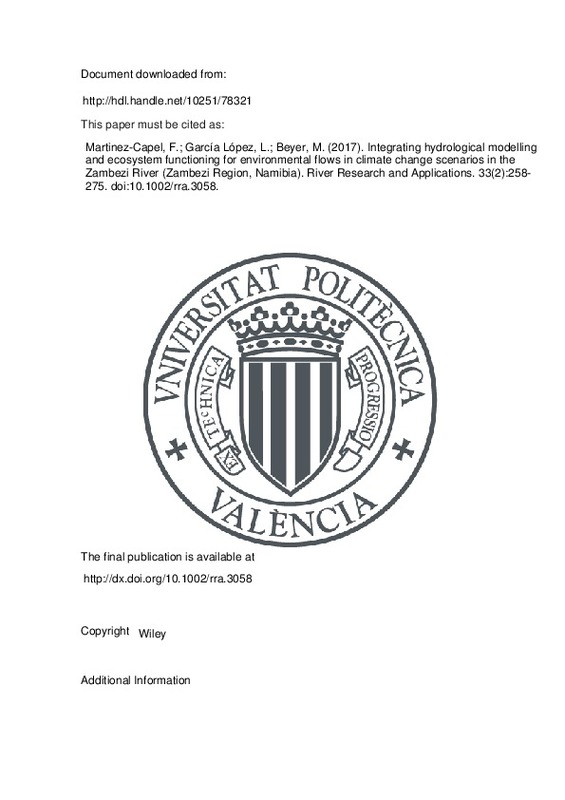JavaScript is disabled for your browser. Some features of this site may not work without it.
Buscar en RiuNet
Listar
Mi cuenta
Estadísticas
Ayuda RiuNet
Admin. UPV
Integrating hydrological modelling and ecosystem functioning for environmental flows in climate change scenarios in the Zambezi River (Zambezi Region, Namibia)
Mostrar el registro sencillo del ítem
Ficheros en el ítem
| dc.contributor.author | Martinez-Capel, Francisco
|
es_ES |
| dc.contributor.author | García López, Lucía
|
es_ES |
| dc.contributor.author | Beyer, Matthias
|
es_ES |
| dc.date.accessioned | 2017-02-27T15:40:02Z | |
| dc.date.available | 2017-02-27T15:40:02Z | |
| dc.date.issued | 2017-02 | |
| dc.identifier.issn | 1535-1459 | |
| dc.identifier.uri | http://hdl.handle.net/10251/78321 | |
| dc.description.abstract | The Zambezi-Chobe wetlands in Namibia are of great international importance for trans-boundary water management because of their remarkable ecological characteristics and the variety and magnitude of the ecosystem services provided. The main objective of this study is to establish the hydro-ecological baseline for the application of environmental flow regimes (EFR). The specific objectives are: (i) the assessment of environmental flow components (EFC) in the current near-natural hydrological conditions; (ii) the generation of future scenarios for climatic and socioeconomic changes; (iii) the estimation of the area duration curves and estimated annual habitat during the inundation of the critical habitats for fisheries (mulapos), under the existing conditions and future scenarios; and (iv) to provide a framework for the future application of EFRs, based on hydrological and ecological processes. To make a sound analysis of the ecological implications, first we develop a conceptual framework of the linkages between the hydrological and biological processes concerning fish communities, because of the critical role of fisheries in the region. The EFCs in near-natural hydrological conditions provide the basis for developing interim EFRs in the region, within the framework of an adaptive management of water resources. The future scenarios indicate a mitigation of the flow variability; and, in the worst-case scenario, the reduction of the maximum flow and inundated area of the mulapos would result in a reduction of the estimated annual habitat of 22%. This means a reduction in the spawning habitats for quiet-water species, in the food resources for fry and juvenile fish and a consequent reduction in fish stocks. Furthermore, the habitat loss during low events is similar and greater under both scenarios, at ca. 35%. Here we corroborate that the EFCs and their variability may become the building blocks of flow-ecology models that lead to environmental flow recommendations, monitoring and research programmes and flow protection activities. | es_ES |
| dc.description.sponsorship | This research was part of the research project CERPA (Certification of Protected Areas), funded by the German Federal Ministry of Education and Research (BMBF), and focused on the evaluation of new market-based instruments for biodiversity conservation and their socioeconomic implications. The authors also thank two anonymous reviewers who provided substantial input that improved the manuscript. The study has been partially funded by the national research project IMPADAPT (CGL2013-48424-C2-1-R), with MINECO (Spanish Ministry of Economy) and FEDER funds. | en_EN |
| dc.language | Inglés | es_ES |
| dc.publisher | Wiley | es_ES |
| dc.relation.ispartof | River Research and Applications | es_ES |
| dc.rights | Reserva de todos los derechos | es_ES |
| dc.subject | Environmental flow regime | es_ES |
| dc.subject | Range of variability approach | es_ES |
| dc.subject | Habitat duration curves | es_ES |
| dc.subject | River flow variability | es_ES |
| dc.subject | Water resources management | es_ES |
| dc.subject | Zambezi river | es_ES |
| dc.subject | Wetlands | es_ES |
| dc.subject | Climate change | es_ES |
| dc.subject.classification | TECNOLOGIA DEL MEDIO AMBIENTE | es_ES |
| dc.title | Integrating hydrological modelling and ecosystem functioning for environmental flows in climate change scenarios in the Zambezi River (Zambezi Region, Namibia) | es_ES |
| dc.type | Artículo | es_ES |
| dc.identifier.doi | 10.1002/rra.3058 | |
| dc.relation.projectID | info:eu-repo/grantAgreement/MINECO//CGL2013-48424-C2-1-R/ES/ADAPTACION AL CAMBIO GLOBAL EN SISTEMAS DE RECURSOS HIDRICOS/ | es_ES |
| dc.rights.accessRights | Abierto | es_ES |
| dc.date.embargoEndDate | 2018-02-01 | es_ES |
| dc.contributor.affiliation | Universitat Politècnica de València. Escuela Politécnica Superior de Gandia - Escola Politècnica Superior de Gandia | es_ES |
| dc.contributor.affiliation | Universitat Politècnica de València. Instituto de Investigación para la Gestión Integral de Zonas Costeras - Institut d'Investigació per a la Gestió Integral de Zones Costaneres | es_ES |
| dc.description.bibliographicCitation | Martinez-Capel, F.; García López, L.; Beyer, M. (2017). Integrating hydrological modelling and ecosystem functioning for environmental flows in climate change scenarios in the Zambezi River (Zambezi Region, Namibia). River Research and Applications. 33(2):258-275. https://doi.org/10.1002/rra.3058 | es_ES |
| dc.description.accrualMethod | S | es_ES |
| dc.relation.publisherversion | http://dx.doi.org/10.1002/rra.3058 | es_ES |
| dc.description.upvformatpinicio | 258 | es_ES |
| dc.description.upvformatpfin | 275 | es_ES |
| dc.type.version | info:eu-repo/semantics/publishedVersion | es_ES |
| dc.description.volume | 33 | es_ES |
| dc.description.issue | 2 | es_ES |
| dc.relation.senia | 321975 | es_ES |
| dc.contributor.funder | Ministerio de Economía y Competitividad | es_ES |
| dc.contributor.funder | Bundesministerium für Bildung und Forschung, Alemania | es_ES |
| dc.contributor.funder | European Regional Development Fund | es_ES |







![[Cerrado]](/themes/UPV/images/candado.png)

